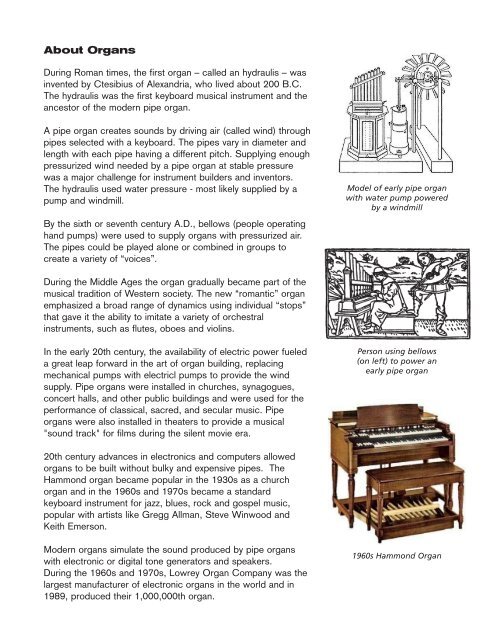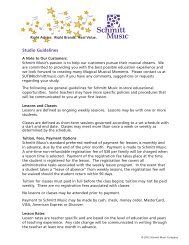You also want an ePaper? Increase the reach of your titles
YUMPU automatically turns print PDFs into web optimized ePapers that Google loves.
<strong>About</strong> <strong>Organs</strong><br />
During Roman times, the first organ – called an hydraulis – was<br />
invented by Ctesibius of Alexandria, who lived about 200 B.C.<br />
The hydraulis was the first keyboard musical instrument and the<br />
ancestor of the modern pipe organ.<br />
A pipe organ creates sounds by driving air (called wind) through<br />
pipes selected with a keyboard. The pipes vary in diameter and<br />
length with each pipe having a different pitch. Supplying enough<br />
pressurized wind needed by a pipe organ at stable pressure<br />
was a major challenge for instrument builders and inventors.<br />
The hydraulis used water pressure - most likely supplied by a<br />
pump and windmill.<br />
By the sixth or seventh century A.D., bellows (people operating<br />
hand pumps) were used to supply organs with pressurized air.<br />
The pipes could be played alone or combined in groups to<br />
create a variety of “voices”.<br />
Model of early pipe organ<br />
with water pump powered<br />
by a windmill<br />
During the Middle Ages the organ gradually became part of the<br />
musical tradition of Western society. The new “romantic” organ<br />
emphasized a broad range of dynamics using individual “stops”<br />
that gave it the ability to imitate a variety of orchestral<br />
instruments, such as flutes, oboes and violins.<br />
In the early 20th century, the availability of electric power fueled<br />
a great leap forward in the art of organ building, replacing<br />
mechanical pumps with electricl pumps to provide the wind<br />
supply. Pipe organs were installed in churches, synagogues,<br />
concert halls, and other public buildings and were used for the<br />
performance of classical, sacred, and secular music. Pipe<br />
organs were also installed in theaters to provide a musical<br />
"sound track" for films during the silent movie era.<br />
Person using bellows<br />
(on left) to power an<br />
early pipe organ<br />
20th century advances in electronics and computers allowed<br />
organs to be built without bulky and expensive pipes. The<br />
Hammond organ became popular in the 1930s as a church<br />
organ and in the 1960s and 1970s became a standard<br />
keyboard instrument for jazz, blues, rock and gospel music,<br />
popular with artists like Gregg Allman, Steve Winwood and<br />
Keith Emerson.<br />
Modern organs simulate the sound produced by pipe organs<br />
with electronic or digital tone generators and speakers.<br />
During the 1960s and 1970s, Lowrey Organ Company was the<br />
largest manufacturer of electronic organs in the world and in<br />
1989, produced their 1,000,000th organ.<br />
1960s Hammond Organ
Lowrey organs differed from Hammond <strong>Organs</strong> with their<br />
addition of "automatic accompaniment" features. While originally<br />
intended for the home entertainment market, Lowrey organs<br />
were also used by some rock groups in the 1960s and 1970s<br />
including The Beatles.<br />
Today Lowrey organs are available in a variety of models with<br />
features to please any musician. For example, the Lowrey Elite<br />
Series Prestige A5000 offers the player 5,799 total presets -<br />
from Theatre, to Country, Big Band, Latin and more!<br />
Here at <strong>Schmitt</strong> <strong>Music</strong>, we have been providing sales, service<br />
and lesson expertise to our neighbors in the Midwest since<br />
1896. We started selling and servicing home organs in 1947<br />
and we haven't stopped! Contact us for more information about<br />
new or used organs or about our popular and affordable<br />
Lowrey Organ Quick Start classes. Call these stores<br />
for more information, or email judy.halvorson@schmittmusic.com<br />
Lowrey Elite Series<br />
Prestige A5000<br />
Roseville: <strong>Schmitt</strong> <strong>Music</strong> in Roseville MN<br />
2436 Cleveland Avenue North<br />
Call (651)636-5614 ask for Al or Steve<br />
Kansas City: <strong>Schmitt</strong> <strong>Music</strong> in Rosana Square<br />
119th & Metcalf, Overland Park KS<br />
Call (913) 653-7000 ask for Ryan or Craig<br />
Burnsville: <strong>Schmitt</strong> <strong>Music</strong> in Burnsville MN<br />
14150 Nicollet Avenue South<br />
Cobblestone Court<br />
Call (952)435-3590 ask for Joanne<br />
Lowrey Entry Level Series<br />
Adventurer II SE2<br />
Denver: Wells <strong>Music</strong> in Denver<br />
685 South Broadway, Denver CO<br />
Just north of I-25 on Broadway<br />
Call (303)777-1900 ask for Don or Barry<br />
Lowrey QUICK START class<br />
Right Advice. Right Brands. Real Value.



